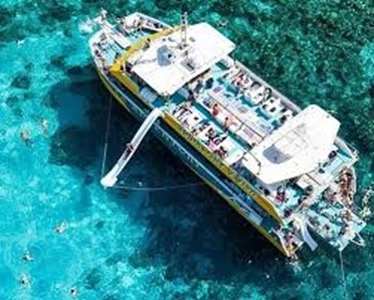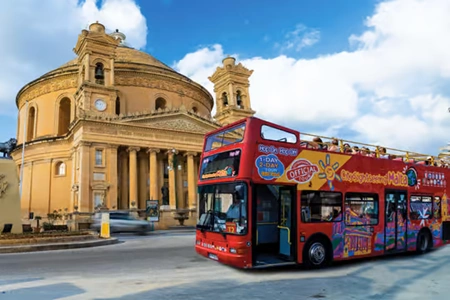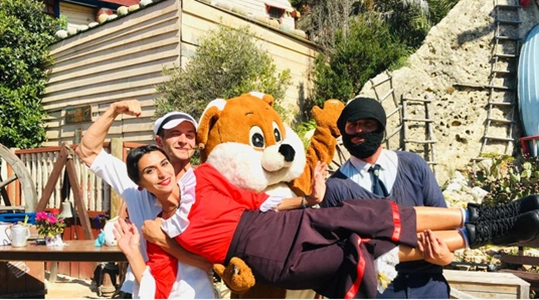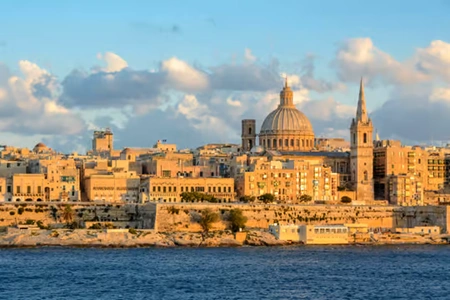Marsaxlokk
When the Phoenicians travelled from Tire and Sidon (now Lebanon) to Malta, they entered the port of Marsaxlokk. From there they travelled on to Tas-Silġ. Archaeological remains of a temple dedicated to Astarte have been discovered in Tas-Silġ.
Little is known about the Middle Ages. In the Ottoman Empire period, easily accessible locations from the sea were virtually uninhabited, because it was often the case that people were killed or taken and sold or used as slaves.
The Ottomans entered Marsaxlokk bay to conquer Malta. This attack is known as the Great Siege of 1565.
In 1614 the Ottoman troops again attempted to attack the island.
Only when the power of the Ottoman Empire diminished did such villages begin to emerge as Marsaxlokk.
In 1890 the village counted 210 people and it was in particular a village that was used as a summer residence. In 1961 the village had 778 people and fishing was of considerable importance.
Marsaxlokk became a parish in 1897.
There is a memorial showing the leader of Soviet Union, Mikhail Gorbachev and the leader of America George H.W. Bush who had a great meeting here to end the cold war.
The fishermen did their work with a fishing boat called a luzzu. This fishing fleet fishes for swordfish and tuna which are caught in abundance between spring and late fall.
Marsaxlokk has its Sunday market, where the fish is sold immediately as soon as the catch arrives. It is also the largest market, where you can buy anything.
The picturesque village now has more than 3,200 inhabitants and is a tourist attraction.
Marsaxlokk Municipality has the following places, areas and Bays: Delimara, Ħal Ġinwi, Il-Ballutbays, Il-Fossa, Il-Magħluq, Il-Wilġa, Kavallerizza, Marnisi, Marsaxlokk Bay, Il-Ponta l-Kbira, San Duminku, St Peter's pool, Il-Ponta Tal-Qrejten, Tal-Wiċċ, Tas-Silġ, Torri San Luċjan, Xorb l-Għaġin, Ruman Gate.
The origin of the name.
The name of the village comes from marsa, which means "port" or "bay" in Arabic, and xlokk, which is the word for southeast.
The inhabitants of the village are called the Xlukkajri.
Chapels and churches
Parish church, Our Lady of Pompei - built in 1890 - 1897 and designed by architect Father Joseph Diacono from Gozo, expanded in 1910 and afterwards the facade was changed.
The feast of Our Dear Lady is held on the last Sunday of July. It includes a procession with the statue and fireworks. A detailed page has been described about this church.
The Chapel of St. Nicholas was rebuilt in 1650 by Mr.Gann Frangisk Gauci.
The Monastery of Our Lady of Tas-Silġ.
The church in Tas-Silġ was built in 1650 and rebuilt in 1833 by the Marquise Angiolina Muscat Cassia Dorell to a plan drawn by Frangisku Fabri from Vittoriosa. The church, overlooking Marsaxlokk, is under the control of the Carmelite Order. Traditionally this church has been visited by farmers and fishermen in the area.
In 1834 the Marquise handed over all its property to the priests to manage it.
In 1927, the Carmelite Order asked their superior for permission to take over the management of this church and its legacy. In 1933 the monks took over this church and the surrounding estate. As soon as the monks took over, they used the adjoining palace as a monastery. November 1934, they had their first novices here.
In 1934, Redent of the Cross blessed a set of three bells cast by Pasquale Marinelli and Son.
In the presence of the Marquise family, the first stone of the new monastery was laid on March 28, 1937, after a design by architect Andrea Micallef from Luqa. The first stone of the monastery was blessed by the Vice-Provincial Father Bernard. The new monastery was completed on October 2, 1939.
In the Second World War the monks had to leave the monastery because this was demanded by the army. On 20 November 1943 the army left, and the monks started using the monastery again.
The present church is quite small and has a dome. It consists of only one altar. The church that stood on the spot before burned down. There is a statue of Our Lady of the Mountain Carmel and one of St. Theresa.
St. Dominic This chapel is part of the Marnisi and was built in 1653. The owners were Jacob Testaferrata and his wife Teodora Bonnici.
St. Paul is a small church built in the 18th century near Xorb il-Għaġin.
St. Peter
A church built to architect Lorenzo Gafa's design and blessed in 1862. The church was enlarged in 1875 by E. Gauci Testaferrata and then embellished by Professor Dr. Nicholas Zammit.
The annual feast of St. Peter takes place on April 29.
St. Peter blessed the olive branches and water. Another blessing reserved only for this church is the blessing of rings to support mothers during their pregnancy.
Six members of the Testaferrata family, Manduca and Gauci family are buried there. This small church has a dome and three altars. The main painting showing St. Peter as a Dominican Martyr was painted by Pascal Buhagiar. The second shows Our Saviour and the third shows Our Lady of the Mountain Carmel painted by Joseph D'Arena. The statue of St. Ann was imported from France.
The Sacred Heart
It is said that the noble Margaret dei Conti Manduca financed this chapel in 1876. This was dedicated to the Sacred Heart and is part of the "Kavallerizza" building.
Jesus of Nazareth Institute
In September 1949 the Missionary Congregation of Jesus of Nazareth started a kindergarten. Children under the age of five could learn to read, write and count.
In 1959 the Preziosi family donated a piece of land in Marsaxlokk to the institute. Within a year, the nuns built a house known as "Domus Marie". The house was blessed by Bishop Emm. Galea. It is now also a home for a few older ladies. There is also a chapel with the name "Our Lady of Sorrows".
Main Archaeological finds:
Roman baths
In March 1932, they dug at the quay near "Torri tal-Pont" and a wall was discovered. After research and removal of a lot of debris, a foundation and two floors covered with tiles were dug up and the remains of a hypovenet (heating of water via a water channel). The building was a Roman villa with thermal baths from the 2nd century AD. the third Roman house with baths on the islands.
A bowl with two handles and three copper coins were also found. One of the coins was a Maltese, with a Greek Melitaion inscription. This coin belonged to 35 or 27 years after Christ. Other copper objects were also dug up.
Logga (Arcade)
An arcade which was built in 1876. The arcade was the length of the central square and was the place where the women from the village did their laundry.
Tas-Silġ Archaeological Complex
In 1876 a group of archaeologists from the "Missione Archaeologica Italiana" dug up the Astarte Sanctuary in Tas-Silġ. Astarte can be identified with the Temple of Juno mentioned by Cicero and the Temple of Hera named by Ptolemy.
Excavations have shown that this area was a shrine from the Prehistoric period (Temple period). Thus, found at this location; earthenware lithics from the Tarxien phase, shards from the Prehistoric Bronze Age, foundations and walls, earthenware, animal bones, pot shards with inscription from the Punic period and materials from the Roman, Byzantine and Medieval periods. (35.845505, 14.551572).
Punic tomb
In 1927 a farmer was tilling his field and accidentally discouvered on a Punic tomb. The objects were already removed. Later, the farmer donated the objects he found to the museum.
Other places of interest
Palazzo Marnisi
Ugolino Bonnici bought the land in 1551. You will also find St. Lucia in this country side. An effiecient palace was built in 1650. On the facade is an inscription which states that under the reign of the then Grandmaster Lascaris the land was purchased 100 years ago by Ugolino Bonnici. In this palace is the Chapel of St. Dominic. (35.844450, 14.535994).
At the tip of Delimara, a dive area with reef can be found that starts at a depth of about 9 meters and gradually drops to 12 meters. It is surrounded by a vertical cliff up to 25 meters, a cave and a vertical tunnel. The bottom is covered with large boulders, under which fish hide. The seabed is made of sand. During a dive you will be introduced to various fish and marine animals.
Delimara Point
In 1853 a lighthouse was built on Delimara Point. It was 150 feet high and gave a red light that was seen from 24 kilometers (15 miles) far. Later it was made to rotate every 30 seconds and the light changed between red and white. This was the second lighthouse built in Malta under Governor O'Farrel.
Gardens
"Ġnien il-Familja" in the residential area.
"Ġnien Guże Cassar" in the port of Port Rohan.
Marsaxlokk has a small sandy beach and the famous St. Peter's pool at Delimara.
Fortifications
Because it is fairly easy to get to the island via the bay of Marsaxlokk and it was an open area, the Ottomans (Turks) and pirates could simply come ashore and plunder supplies and kill people or enslave them. It was therefore necessary to build Fortifications here and to protect the inhabitants or the land.
The tower of St. Lucian
The tower was built under the reign of Alof Wignacourt in the period 1610 - 1611. A detailed page about the watch towers is included in the app. In the tower was a small chapel dedicated to St. Lucian. Much later, when it was partially abandoned, the photo of St. Lucian was found in the Parish Church of Tarxien.
Marnizi tower
This tower stands on the hill Il-Barumbara ta Labert and was built in 1719. Under the reign of Grandmaster Marc'Antonio Zondadari it was equipped in 1721 with two cannons and trenches with a further 56 cannons. The tower is also known as the "White tower".
Bettina Tower
This guard tower was built by Grandmaster Pinto in 1751. It contained two guns. Based on a design by engineer Burlemach, the tower was supplemented in 1761 with an artillery battery with 10 guns. The tower has since been demolished. In the British period, various works were produced on the basis of new defense insights. Unfortunately, most have been demolished, but the list below provides a good understanding of the defense in a relatively small area.
Delimara Fort
Built in 1880 in Delimara. The construction took five years. It had a rolling bridge and was equipped with six guns.
Tas-Silġ Fortress
Completed in 1883 and it had four guns.
St. Paul
The Artillery battery was built in 1843 at Delimara and had two guns.
Kavallerizza
Not far from St. Lucian's Tower, horse stables / riding stables were built during the reign of Grandmaster Alof de Wignacourt. Here the knights practiced equestrian sport.
The officers were stationed there during the First World War. During the Second World War it served as the General Headquarters for the RAF. It is currently in private hands.
Around 1930 the bay was used by four-engine short C-class seaplanes from Britain's Imperial Airways.
During the Second World War, the Marsaxlokk bay was the base for the Fleet Air Arm.





